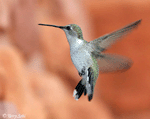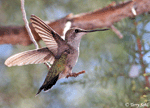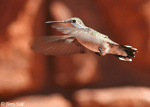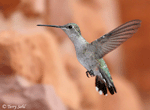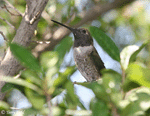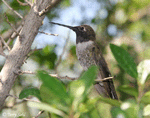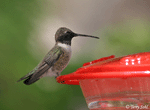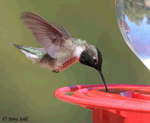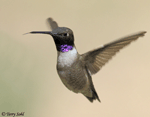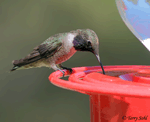| Length: 3.75 inches | Wingspan: 4.75 inches | Seasonality: Non-resident in South Dakota |
| ID Keys: Dark gorget on male shows very dark purple in the right light; long, very slightly downcurved bill | ||
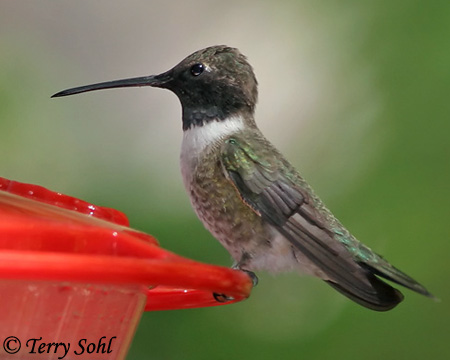 The
Black-chinned Hummingbird is widely distributed in the western part of the
United States in the summer. They are very closely related to their
eastern U.S. counterpart, the
Ruby-throated Hummingbird. Plumages between the two species are
almost identical, and one of the few reliable differences is the color of
the male's gorget when seen in good light, with Black-chinned Hummingbirds
flashing a purple band on their gorget, and
Ruby-throated Hummingbirds
showing a red band. They are common in low-elevations and around urban
feeders in the Western U.S. in the summer, but unlike some western
Hummingbirds, Black-chinned Hummingbirds completely disappear from the West
in the winter as they migrate to spend the winters in Mexico.
The
Black-chinned Hummingbird is widely distributed in the western part of the
United States in the summer. They are very closely related to their
eastern U.S. counterpart, the
Ruby-throated Hummingbird. Plumages between the two species are
almost identical, and one of the few reliable differences is the color of
the male's gorget when seen in good light, with Black-chinned Hummingbirds
flashing a purple band on their gorget, and
Ruby-throated Hummingbirds
showing a red band. They are common in low-elevations and around urban
feeders in the Western U.S. in the summer, but unlike some western
Hummingbirds, Black-chinned Hummingbirds completely disappear from the West
in the winter as they migrate to spend the winters in Mexico.
Habitat: Black-chinned Hummingbirds can be found in a variety of open to semi-open habitats, including suburban areas, riparian areas, open woodland, and deciduous groves in canyons of the West.
Diet: Typical diet of Hummingbirds, feeding heavily on nectar. Tiny insects also comprise a large portion of the diet.
Behavior: Black-chinned Hummingbirds are extremely adaptable, both in terms of habitat and in terms of food supply. They have adapted to a variety of settings in the West, including urban settings, and will adapt foraging techniques and food supply depending upon availability, with less of a tendency to specialize on one food source than some hummingbirds.
Nesting: Nests are typically constructed relatively close to the ground, from 3 to 12 feet in height. The nests are composed of downy plant fibers and spider webs. Females exclusively incubate and raise young.
Interactive eBird Map: Click to access an interactive eBird map of Black-chinned Hummingbird sightings
Song: Song of the Black-chinned Hummingbird is a very weak, high-pitched warbling. Black-chinned Hummingbirds also have a wide variety of calls, most often produced during courtship and other interactions between birds.
Migration: Black-chinned Hummingbirds are strongly migratory. Birds in the United States arrive in the spring and leave in the fall. A few seem to stray to the eastern U.S. every fall, and a few may actually winter along the Gulf Coast.
Feeders: Will attend hummingbird feeders
Similar Species: Ruby-throated Hummingbird, Anna's Hummingbird
Conservation Status: Common and widespread, with no significant conservation concerns.
Further Information: 1) WhatBird - Black-chinned Hummingbird
2) Audubon Guide - Black-chinned Hummingbird
3) BirdWeb - Black-chinned Hummingbird
Photo Information: May 4th, 2008 - Ramsey Canyon, Arizona - Terry Sohl
Additional Photos: Click on the images or photo names below for additional higher-resolution photos.
| Click below for a higher-resolution map |
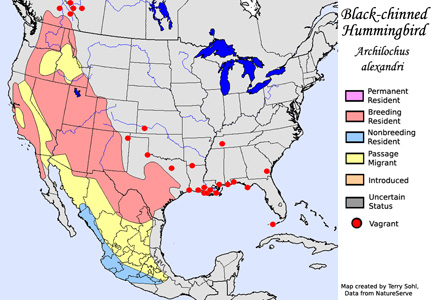 |
| South Dakota Status: Non-resident in South Dakota |
Additional Black-chinned Hummingbird Photos
Click for a higher-resolution version of these photos
